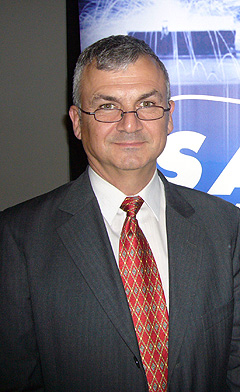News - General News - PartsEngineers call for new Australian auto policyParallels: Volkswagen manages high German wage levels by using heavy automation in its European plants. More robots and regions needed for Australian automotive industry7 Jun 2013 By IAN PORTER AUSTRALIAN car-makers and parts suppliers need to embrace more technology and consider fewer human workers, says a leading automotive engineer At the same time, the government’s future automotive industry policy needs to incentivise local companies to expand beyond our borders into regional markets. “We have to learn from overseas. How do other countries do it that have high wages, that have other high costs, that don’t have natural resources?” says president of the Society of Automotive Engineers-Australasia Bill Malkoutzis. “There needs to be a holistic approach by the government that addresses the overall industry, not just individual manufacturers and importers.” Mr Malkoutzis was speaking in an address to the society’s annual meeting last week. “The Australian industry needs a low labor input, possibly robots with supporting technicians, and building in volumes high enough to amortise the high cost of technical content so it competes with low Asian labor rates,” he said. “There will also be a need for detailed policies to ensure a true level playing field is achieved to open the markets that are currently closed to Australian manufacturers.”  Left: President of the Society of Automotive Engineers-Australasia Bill Malkoutzis. Left: President of the Society of Automotive Engineers-Australasia Bill Malkoutzis.He said Australia needed to go back to the approach the late Senator John Button adopted when he drew up what became known as the Button Plan. Mr Malkoutzis said the Button Plan was designed specifically for the Australian industry, addressing it weaknesses and building on its strengths. “But that plan is 30 years old now,” he said. “We need another one of those where we seriously look at what makes the industry work right now, how other people are surviving, and adapt to that. “Then the government can spend its money in a very effective, pointed way to facilitate that (success) in our own country.” As for high-cost industries, Mr Malkoutzis said he had toured the Volkswagen plant at Wolfsburg. “They build half a million Golfs a year in that plant. How do they do that with German wages? “There is a whole underground plant that builds the bodies and paints them underground. How many technicians do they have in that area? At one point it was only 16. “Upstairs there were staff putting the components on, with a lot of smart assembly equipment, and there was a material control management system up in the roof that presented parts at the right time. “It took lots of money, technology, tooling, technicians left right and centre and few people actually putting the thing together. They spat a Golf out every six seconds,” he said. He said the way to achieve significant volumes in Australia was for the government to strike deals with the manufacturers so they could become regional suppliers. “The Government has to go to these companies and say we’d like to make you a regional manufacturer, what is it going to take to do it, to make you profitable and to sell in volume? We struggle with that.” He concedes that this approach means Australian policy has to make Australia more attractive to the car-makers than Thailand, say, at least for some vehicles or products. “It might be through specific grants or tax deduction benefits, like for tooling. Instead of 10 years, let them write it off in two years. That’s only one example.” However, Mr Malkoutzis also singled out market access as a necessary part of any new plan, and that meant taking a harder line in free trade agreement negotiations. “The government has to look at agreements it is about to sign more carefully to ensure that they are real, open free trade arrangements.” He said Australia should not allow itself to be tricked again, as it was by Thailand after the two countries signed another lop-sided FTA which stripped away all of Australia’s automotive tariffs for Thai exports but left tariffs in place in Thailand against Australian exports. After that deal was signed, the Thai government then raised the sales tax on vehicles with engine capacities above 3.0-litres to 100 per cent, to make doubly sure Australia could never export to Thailand. Mr Malkoutzis also has a plan to cope with the carbon tax and its effect – which Toyota says is around $115 per car – on Australian industry. “The carbon tax is fine by me, as long as every car that gets shipped in from overseas that does not pay a carbon tax gets equalized when it gets here,” he said. They should also pay a carbon tax on the energy used to ship the vehicles to Australia. “Every imported car should pay its fair share of carbon tax, then everyone is on the same playing field.”  Read more |
Click to shareGeneral News articlesResearch General News Motor industry news |
















Facebook Twitter Instagram